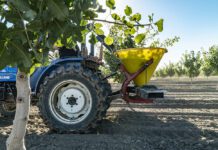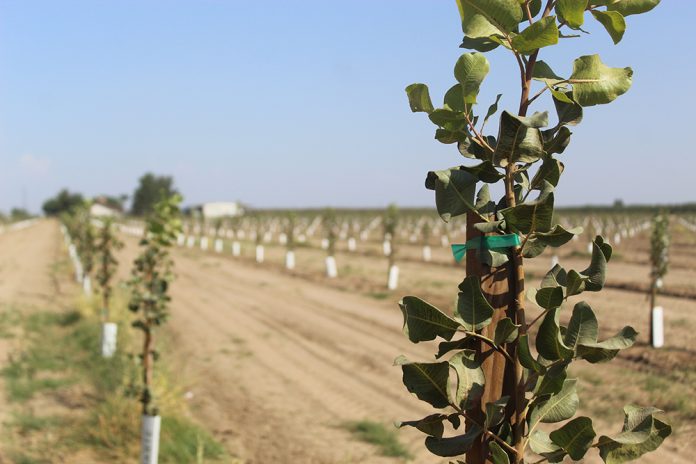
It looks as though odd-numbered years are the new on years, according to Richard Matoian, president of American Pistachio Growers (APG), and that, in large part, has helped drive another consecutive record crop. Matoian said the industry is looking at a significant increase from about 884 million pounds produced in 2022 to the 1.3-billion-pound mark in 2023, and those record crops are likely to keep coming according to a recent industry report.
A production report commissioned by APG in late September by Dennis H. Tootelian of the Tootelian Company of Sacramento, forecasted annual pistachio production from 2023 through 2031. The report projected the total number of acres in California will grow by 28,489 per year from 2023 through 2031 to total nearly 811,300 acres. It also said as new orchards mature, bearing acreage is expected to grow by 5.1% annually, meaning the 2031 crop will come from 668,850 bearing acres.
“Since the year 2000, walnuts have grown three-fold, almonds have grown four-fold and we have grown seven-fold,” Matoian said.
All this growth begs the question: how to move increasingly large crops while maintaining prices to growers. Those in the pistachio industry are holding out hope that the price doesn’t decline in the same way as some other commodities have, but time will tell.
“What we do see is that it took us 30+ years to get our first billion-pound crop,” Matoian said. “In less than 10 years, we’re going to hit our second billion pound, doubling the size of the crop by 2031.”
This year’s crop is also producing larger-sized nuts than an average on year.
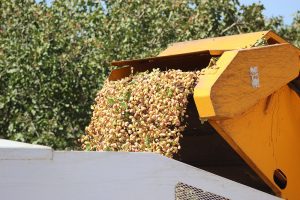
Larger Crops and High Quality
“Typically, with a larger crop, the individual size of the nuts would be smaller, just because the tree has to support more nuts, but it looks like we are also blessed with larger sized nuts,” he said.
There are likely a few reasons for that. An adequate water supply, thanks to a very wet winter, allowed trees to grow and nuts to thrive, while cooler spring temperatures helped produce those larger nuts.
Overall, nut quality going into the beginning of harvest was looking very good as well, Matoian said. Insect damage from pests like naval orangeworm (NOW) was relatively low, the open in-shell split percentages were high, and staining, which could have been a big issue after such a wet winter and August’s Tropical Storm Hilary, was lower than expected.
“Fortunately, while staining is up, it’s not as bad as it could have been,” Matoian said.
Justin Wylie, who grows both conventional and certified organic in Madera, Calif., said the winter soak, followed by a nice spring, was great for his crop.
“The trees came out a lot happier, a lot healthier, salts are down in the soil,” he said, “Honestly, it’s been a pretty good season.”
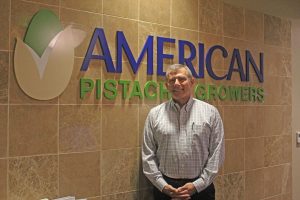
Processors have also spent the last year anticipating the large crop. Rudy Placencia, Chief Operations Officer at Touchstone Pistachio, says they geared up ahead of the busy season expecting to have very little downtime during the seven-to-ten-day window when loads come in.
“What that means is, have we done the right preventative maintenance, do we have the appropriate spare parts in place in the event that something needs to be replaced, so kind of going through that exercise and making sure that seven to ten days, that we’ve made the necessary preparations to ensure minimal downtime and maximum throughput,” Placencia said.
One of the biggest handicaps of the industry, Placencia says, is processing capacity as it relates to hulling, drying and silo storage. From a processor standpoint, he said his operation had to look at their efficiencies on the hulling and drying side to determine what improvements had to be made, knowing that with such a large crop this year, processors wouldn’t have the luxury of counting on a backup hulling line if something broke down.
He said those preventative measures, which required close coordination with their farming operation, ensuring they had full visibility on loads coming in, and understanding load counts, paid off.
“It showed,” he said, “we didn’t have some of the same issues we’ve had in the past.
Success Isn’t Without Challenges
Although most of the American pistachio supply is grown in California’s southern San Joaquin Valley, Matoian said they are seeing a trend of more acreage being planted in the Sacramento Valley and even further up north. While growers in those areas will have to navigate their own set of challenges, the industry as a whole will be keeping an eye on many of the same issues like water and pests.
The future of crops grown in the southern San Joaquin Valley “white lands” areas that rely solely on single-source groundwater will eventually start to feel the effects of Sustainable Groundwater Management Act (SGMA) regulations. Matoian said a study conducted by Land IQ last year determined that about 25% of APG’s growers fall within those affected regions.
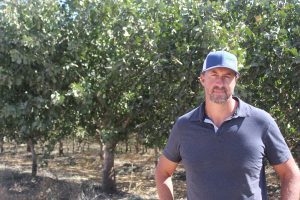
“Growers that have any commodity in those areas are going to be the first to be impacted by the implementation of SGMA, so future production could be affected,” he said.
On the pest front, NOW, which has seen a large uptick in damage to walnuts and almonds this year, could also be a growing threat to pistachios. Wylie said while all their loads had been clean of the pest midway through harvest, he was concerned because trap counts had been extremely high in the months leading up to harvest.
“Our trap counts around here have been consistently higher than we’ve ever seen, so that’s one of the reasons were scrambling to try to get everything out, because we would assume there’s some potential for damage,” he said.
By the last week of September, Wylie said his first shake averaged 0.47% insect damage, with still a few weeks to go for final shaking. On the certified organic end of his operation, he said his biggest issue to controlling pests is trying to metabolize the nitrates out of the trees, so keeping a close eye on balancing the nutrients is key.
As the market demand for pistachios has grown, another major issue Wylie said growers are dealing with is the cost of shipping containers.
“The price of containers shot up something like 10 times during COVID-19,” he said. He added they had been consistently outbid on containers by other industries who can afford to compete overseas, like electronics companies.
Holding on to the Success
As walnut and almond markets are reeling from a downturn and low prices, it leaves the question of how the pistachio industry will avoid a similar fate. With pistachio-loving markets like China and the EU, the trademark green nut has plenty of places to land right now. There are some challenges there as well though, like having to work with tight pesticide residue rules in the EU and high tariffs in places like China. Still, about 70% of pistachios produced in the Western US are exported and that rate could continue to grow.
With such a large crop and even larger crops expected in the coming years, Matoian said there will be a focus on preventing an oversupply situation and keeping it from suffering like other nut industries have. He said APG’s focus will include continuing to market their products to ensure the industry feels the positive momentum of this record crop and the ones to come.
Marketing ahead of the anticipated production is a distinctive aspect of the pistachio industry, Matoian added, since trees have a long lead time from planting to production. APG will be focusing on marketing in new parts of the world, like Mexico, which APG sees as a gateway into South America, as they plan for larger crops,
“We have a sense of what the crop size is going to be for several years out, and because of that we also plan for our marketing and consumer education campaigns to address the production that’s coming,” he said.



